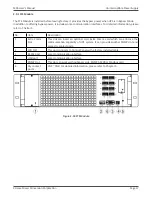
Xtreme Power Conversion Corporation
M90 User’s Manual
Page 5
Uninterruptible Power Supply
2.
Use tools with insulated handles.
3. Wear rubber gloves and boots.
4.
Do not lay tools or metal parts on top of batteries or battery cabinets.
5.
Disconnect the charging source prior to connecting or disconnecting terminal.
6. Check if the battery is inadvertently grounded. If it is, remove the source of grounding. Contacting
with any part of the ground might result in electrical shock. The likelihood of such shock can be
prevented if such grounds are removed during installation and maintenance.
• UPS is designed to supply power even when disconnected from the utility power. After disconnect the util
-
ity and DC power, authorized service personnel should attempt internal access to the UPS.
• Do not disconnect the batteries while the UPS is in Battery mode.
• Disconnect the charging source prior to connecting or disconnecting terminals.
• Batteries can result in a risk of electrical shock or burn from high short circuit current.
• When replacing batteries, use the same number of sealed, lead-acid batteries.
• Do not open or mutilate the battery. Release electrolyte is harmful to the skin and eyes, and may be toxic.
1.5 Recycling the Used Battery
• Do not dispose of the battery in a fire. Battery may explode. Proper disposal of battery is required. Refer
to your local codes for disposal requirements.
• Do not open or mutilate the battery. Released electrolyte is harmful to the skin and eyes. It may be toxic.
• Do not discard the UPS or the UPS batteries in the trash. This product contains sealed, lead-acid batteries
and must be disposed properly. For more information, contact your local recycling/reuse or hazardous
waste center.
• Do not discard waste electrical or electronic equipment (WEEE) in the trash. For proper disposal, contact
your local recycling/reuse or hazardous waste center.
2 Installation
2.1 Initial Inspection
1.
Visually examine if there is any damage inside and outside of packages in the process of the transportation. If
any damage, report it to the carrier immediately.
2.
Verify the product label and confirm the consistency of the equipment.
3. If the equipment needs to be returned, carefully repack the equipment by using the original packing material
that came with.
2.2 Installation Environment
1.
The UPS is designed for indoor use only and should be located in a clean environment with adequate ventila
-
tion to keep the environmental parameters within the required specification.
2.
Make sure that transportation routes (e.g. corridor, door gate, elevator, etc.) and installation area can accom
-
modate and bear the weight of the UPS, the external battery cabinet and handling equipment.
3. The UPS uses forced convection cooling by internal fans. Cooling air enters the module through ventilation
grills located at the front of the cabinet and exhausted through grills located in the rear part of the cabinet.
Please do not block the ventilation holes.
4.
Ensure that the installation area is spacious for maintenance and ventilation.
5.
Operating temperature range is 0–40°C (32–104°F) and humidity up to 90%. Reference M90 altitude and tem
-
perature derating chart for specific applications. Lead Acid battery life is reduced above 25°C (77F).
6. If necessary, install a system of room extractor fans to avoid formation of room temperature. Air filters are
necessary if the UPS is operated in a dusty environment.





































